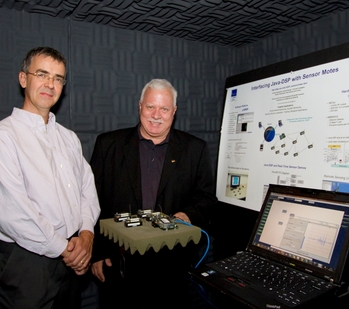
International alliances to boost reach of research consortium
The center’s research encompasses development of a broad array of digital signal processing, imaging and communications algorithms for sensor technologies, including those used in chemical sensors, cell phones, and radar and sonar systems.
This year SenSIP has begun developing a multi-university collaboration with the University of Cyprus, Polytechnic Milano in Italy, ETH Zurich (the Swiss Federal Institute of Technology) and Boston University.

Electrical engineering professors Trevor Thornton (left) and Andreas Spanias stand inside the Anechoic Chamber, a non-echoing space designed to prevent reflections of sound waves. The facility is used to conduct research for ASU’s Sensor, Signal and Information Processing center. Spanias displays a wireless sensor network that consists of wireless sensor circuits, which form a network to communicate with a central station (called a fusion center) that receives and combines all sensor data. The ASU Java-DSP (J-DSP) software controls the sensors and monitors all the received data: audio, temperature, light, and movement. The J-DSP algorithmic functions extract and display information and perform all the necessary computations to characterize an audio scene, detect footsteps, locate people and provide voice recognition. Photo by: Jessica Slater/ASU
The partnership is undertaking a far-ranging project based at the University of Cyprus KIOS Research Center for Intelligent Systems and Networks to accelerate technological advancements for use in sensor networks, “smart” power grids and telecommunications systems.
The endeavor is being supported by the European Union through funding from the Cyprus Research Promotion Foundation.
New UK connection
Most recently, the Imperial College London, one of the leading science and engineering universities in Europe, has become a SenSIP partner.
Imperial College is the home of the University Defence Research Centre (UDRC) – funded by the United Kingdom’s Ministry of Defence – which pursues advances in signal processing technology for use in national defense systems.
A joint project involving Imperial College’s UDRC and ASU’s SenSIP has been granted support from the prestigious British Council UK Prime Minister Fund. It was one of fewer than 30 research projects selected for funding from among 230 recent proposals to the British Council.
SenSIP is directed by Andreas Spanias, a professor in the School of Electrical, Computing and Energy Engineering, one of ASU’s Ira A. Fulton Schools of Engineering.
He has led efforts to establish the new partnership, along with fellow ASU electrical engineering professor Trevor Thornton, director of ASU’s Center for Sold State Electronics Research.
Spanias and Thornton recently joined Imperial College professors Eric Yeatman, Athanassios Manikas and Tony Konstantinides in London to present information on their research project on nanopore sensors and give British Ministry of Defense officials an overview of SenSIP’s research.
“The collaboration brings together two world-class signal-processing research centers,” says Manikas, chair of the communications technology research group in Imperial College’s Department of Electrical and Electronic Engineering.
In addition, Manikas notes, SenSIP’s partnership with Imperial College’s UDRC will enable the ASU center to share resources with 12 United Kingdom universities and six multinational companies.
“This provides a global forum enabling the signal-processing research community to share experiences and encourage cross-fertilization of ideas and strategies,” Manikas says.
Benefits for industry
“This collaboration will help accelerate the advance of sensor-array technology for the benefit of both countries,” says Cynthia Jaskie, president of BRE Systems, based in Scottsdale, Ariz., an information technology and computer consulting company and associate member-at-large of the SenSIP consortium.
The wireless sensor array with integrated data fusion that SenSIP will develop with its news partner “is an important technology with immediate military and security applications,” Jaskie says.
The partnership’s research focus aligns with the goals of the U.S. Department of Defense Small Business Innovation Research Program, says Joseph Marvin, president of Prime Solutions Group, an Arizona aerospace industry consulting firm, and a SenSIP consortium member.
“The work will add tremendous value to the emerging portfolio of aerospace and defense initiatives in Arizona targeted at a global community,” Marvin says.
Sprint, the global voice, data and Internet services provider, will support the partnership with donation of a state-of-the-art 4G network for use in research on interfacing sensor networks with smart phone systems for time-critical applications.
“This research is important to Sprint/Nextel,” says Debbie Vogel, a Sprint account manager in Phoenix. “It will provide test data on the throughput and capacity of our network.”
Extensive collaborations
More than a dozen ASU electrical and computer engineering faculty contribute to SenSIP’s work.
Established in 2007, the center is part of an industry-university consortium that has attracted support from numerous companies in signal processing and communications technology industries and established collaborations with leading research institutions such as Johns Hopkins, Princeton and Purdue universities, among others.
SenSIP’s industry partners include Intel, LG Electronics, Lockheed Martin, National Instruments, Raytheon Missile Systems, Sprint Communications, Brainstorm Technology, IQ Engines, and Acoustic Technologies.
In 2010, SenSIP earned designation as a National Science Foundation Industry/University Collaborative Research Center and became a partner with a similar consortium led by researchers at four Texas universities.
The consortium, called Net-Centric, includes major industry members such as Hewlett-Packard, Texas Instruments and Boeing.
SenSIP also collaborates closely with ASU’s School of Arts, Media and Engineering on research in sensor systems and algorithms for video and audio scene analysis for dual-use applications in security systems and computer gaming.
In addition, SenSIP research partnerships involve work on chemical sensors with ASU’s Biodesign Institute, and research on signal processing algorithms for threat detection for the Security and Defense Systems Initiative in the Ira A. Fulton Schools of Engineering.
Written by Joe Kullman and Natalie Pierce



































